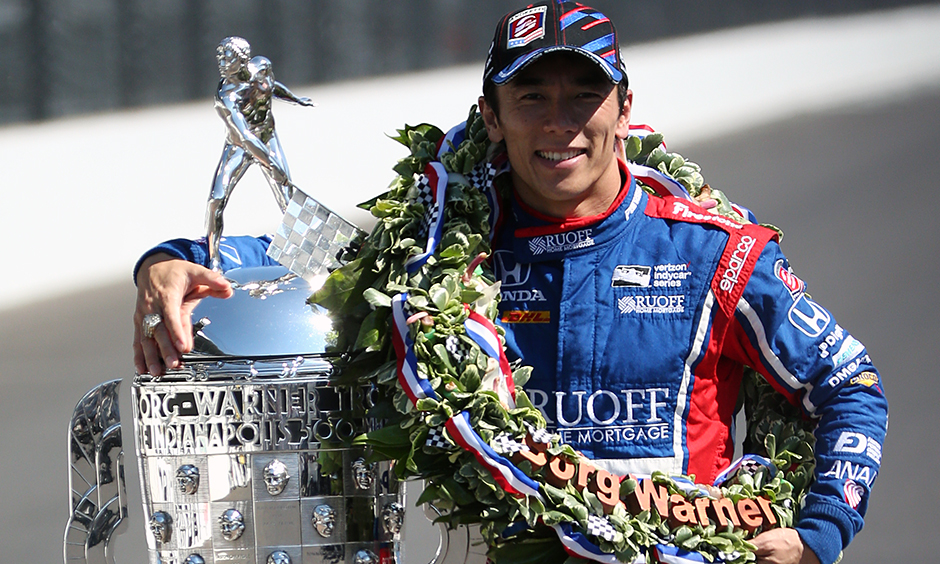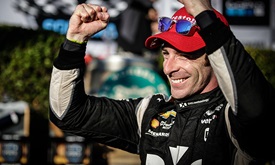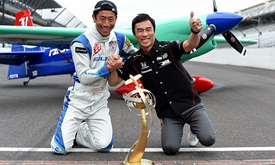Sato ready to unveil likeness on Borg-Warner Trophy today
OCT 17, 2017
When Takuma Sato’s likeness on the Borg-Warner Trophy is unveiled today at the Indianapolis Motor Speedway Museum, it will become the 104th face to be immortalized on one of the most coveted trophies in the world of sports.
The Borg-Warner Trophy pays tribute year-round to many of the most revered drivers in auto racing history, including 2017 Indianapolis 500 presented by PennGrade Motor Oil winner Sato. It also becomes the focal point each May for the drivers competing in “The Greatest Spectacle in Racing,” a reminder of the glory and tradition associated with winning the world’s most prestigious auto race.
Sato will help unveil his likeness on the trophy at 5 p.m. ET today the IMS Museum. Attendance for the unveiling is included with price of admission to the museum ($10).
Sato, driving for Andretti Autosport, won this year's Indy 500 by 0.2011 of a second following a thrilling duel with three-time race winner Helio Castroneves. In doing so, he became the first Japanese driver to capture the race. The 40-year-old from Tokyo is moving to Rahal Letterman Lanigan Racing for 2018 Verizon IndyCar Series competition.
Winning the Indianapolis 500 comes with the honor of having one’s face sculpted onto the 81-year-old trophy. Separate squares are affixed to its sterling-silver body, on which each winner’s face, name and winning year are permanently etched.
Famed sculptor William Behrends has created each winner’s face in clay since 1990, a total of 28 likenesses. That final image is cast in a sterling-silver, bas-relief likeness the size of an egg and placed on the trophy.
The only likeness on the trophy not cast in sterling silver is a 24-karat gold portrait of Tony Hulman, who saved IMS when he purchased it in 1945. Hulman’s image was added in 1987. The Hulman-George family continues to own IMS today.
In 1935, the Borg-Warner Automotive Company (now called BorgWarner) commissioned designer Robert J. Hill and Spaulding-Gorham, Inc., of Chicago, to create the trophy at a cost of $10,000.
Unveiled at a 1936 dinner hosted by then-IMS owner Eddie Rickenbacker, the Borg-Warner Trophy was officially declared the prize for Indianapolis 500 winners. It was first presented that same year to champion Louis Meyer, who said, “Winning the Borg-Warner Trophy is like winning an Olympic medal.”
The trophy was refurbished in 1992 and is valued today at $3.5 million. Every Indianapolis 500 winner’s face is immortalized on the trophy, all the way back to Ray Harroun, victor of the inaugural race in 1911. There also are two sets of dual victors’ faces on the trophy from the era when primary drivers often shared cars with relief drivers: L.L. Corum and Joe Boyer in 1924 and Floyd Davis and Mauri Rose in 1941.
Four-time champions A.J. Foyt (1961, 1964, 1967, 1977), Al Unser (1970, 1971, 1978, 1987) and Rick Mears (1979, 1984, 1988, 1991) are the only drivers with their image on the trophy more than three times. Mears is the only one of that trio to have a new likeness rendered for each of his four victories.
The last driver to have his likeness placed on the original trophy was Bobby Rahal in 1986, as all the squares had been filled. A new base was added in 1987 and was filled after Gil de Ferran’s victory in 2003. BorgWarner commissioned a new base for 2004 that will not be filled to capacity until 2034.
Without the base, the trophy stands 52 inches tall. With the base, it is 64.75 inches tall and weighs about 110 pounds.
Since 1988, an 18-inch replica of the trophy, a “Baby Borg,” has been crafted in sterling silver for presentation to the champion. BorgWarner expanded that new tradition in 1997 by also presenting the winning car owner with a “Baby Borg.”
Today’s unveiling will stream live on the IMS Facebook page at 5 p.m. Click here to watch.



















